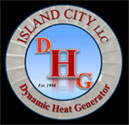Island City's Dynamic Heat Generator
The Dynamic Heat Generator (DHG) was developed following a request in 1999. It was first used in the oil field market to maintain diesel engine temperatures during idle. With a robust construction, fast heat rise and overall superior performance, the heaters offered the oil field market a product that was easy to gain trust in.
With its instant success, the heater’s list of applications expanded beyond just engines. The oil field service sector requested larger models to fill their heating needs primarily for N2 and Water Frac. Though, it has been used throughout the oil field sector for blending, deck and also cabin heating. They replaced fuel style boilers with units that were not only more efficient, but also easier to package due to their compact size and flexibility of input and output drive options.

Markets
The DHG continues to expand into new markets. Its ability to heat fluids directly, have quick heat rise and have an excellent heat recovery make the DHG sought after. With over 48 different models, the DHG sets itself apart by being able to produce heat with a multitude of fluids in an array of temperature bands.
Island City’s Dynamic Heat Generator(DHG) continues to break new ground in the shear heating market every day and has lead the company to become an “Industry Standard” in shear heating and further to become the - Largest Manufacturer Of Dynamic Heaters In The World -









Connect with us
Contact us today for more information
Office: 715-536-8600
Cell: 920-540-6086